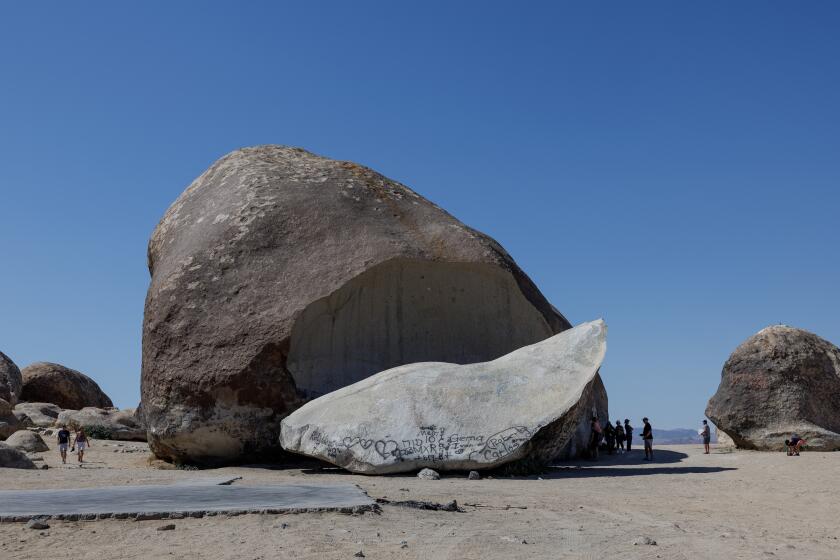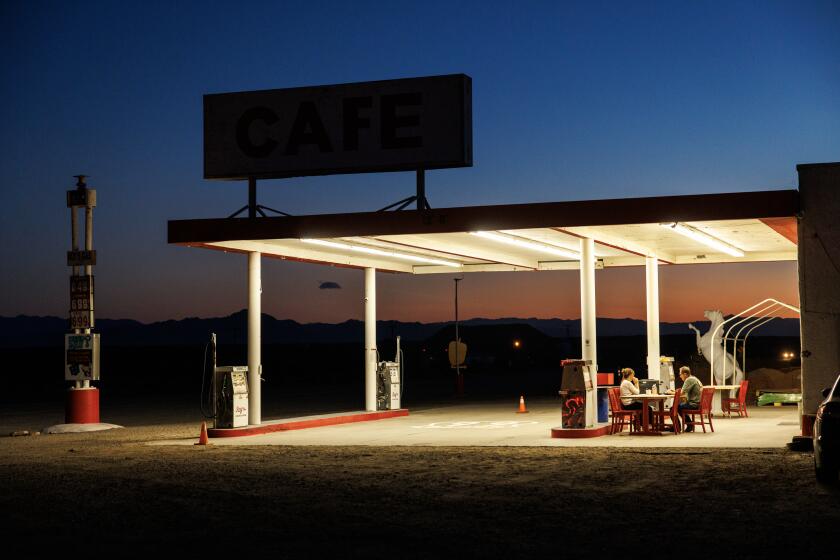
- Share via
TWENTYNINE PALMS, Calif. — When Mary Firestine woke up, she didn’t know it was going to rain. Weather forecasts for that mid-July Sunday in the rural desert city of Twentynine Palms showed just a slight chance.
But that afternoon, the sky darkened and the wind howled. The clouds spit out quarter-sized hail.
Aggressive and impactful reporting on climate change, the environment, health and science.
Water poured in through Firestine’s sliding back door. She tried to stanch the flow with blankets, sheets and pillows. But then the water seeped in through her walls. As she stuffed more linens around the baseboards, water flowed from beneath her kitchen cabinets and through her bathroom. She grabbed clothes from her closet and rolls of toilet paper in a desperate attempt to soak it up. In the midst of it all, she received a flash flood alert on her phone.
The 61-year-old cosmetologist has weathered many monsoons, which typically hit the Mojave Desert from July to September. But this one came as a surprise — both for its intensity, and the fact that it flooded her neighborhood, which she described as a first in her 36 years there.
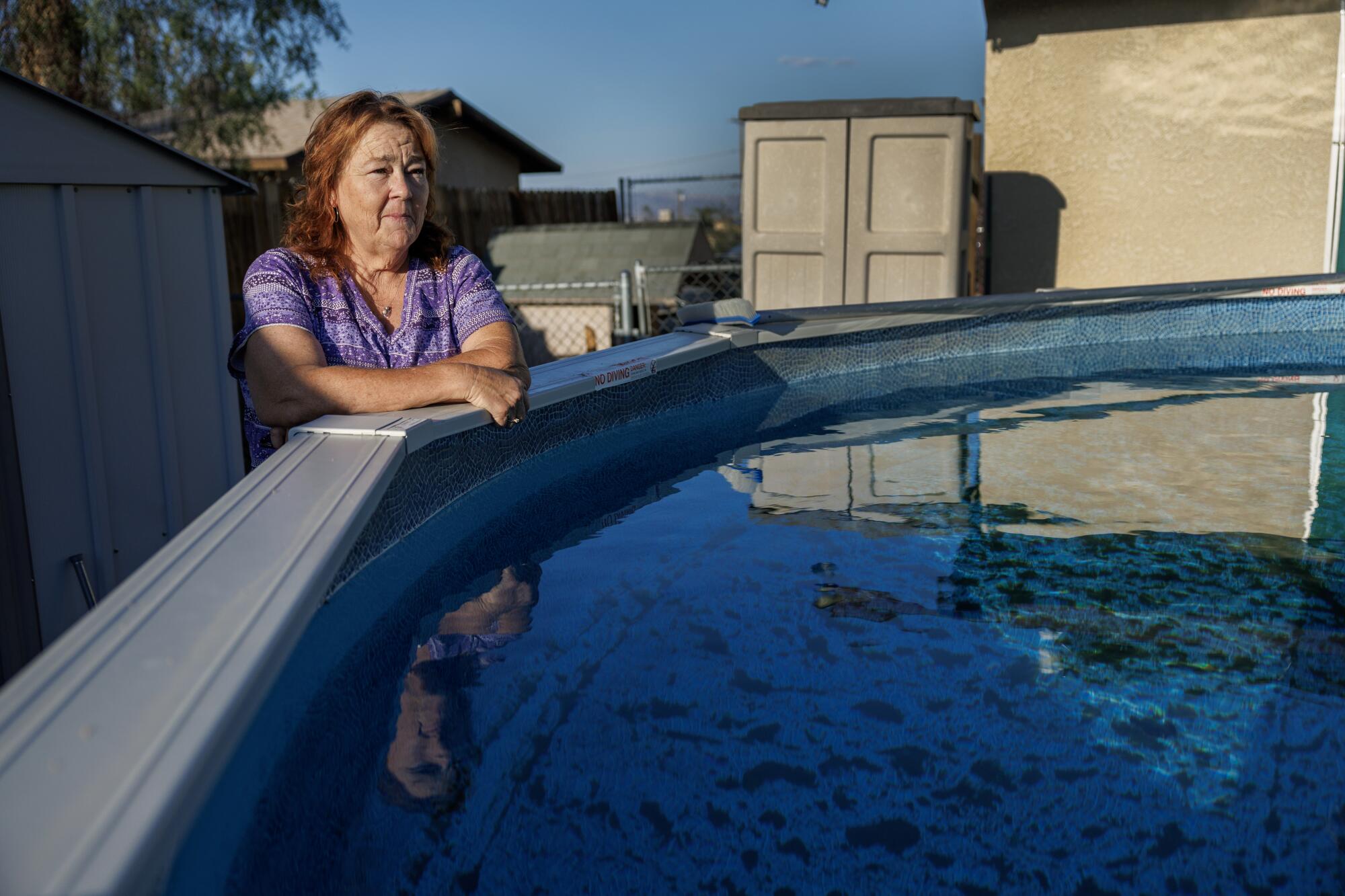
“My home is not even in a flood zone, so I never expected that,” she said. Like many desert residents, she doesn’t have flood insurance, and homeowner’s insurance won’t cover the damage.
The surprise storm devastated pockets of Twentynine Palms, sending motorists floating down the main highway, displacing people from their homes and leaving many wondering why the damage was so extensive — and why they didn’t get more warning. But the event, as well as several smaller storms that followed, also revealed a resilient community whose members have banded together to help one another recover.
Difficult to forecast
The July 14 storm developed extremely quickly, said Ashley Nickerson, a meteorologist with the National Weather Service in Las Vegas. In just two to three hours, roughly 1.88 inches of rain fell on Twentynine Palms, which normally gets 3.87 inches in a year, she said.
Monsoon storms typically form when an area of high pressure draws moisture up from the Baja Peninsula and other parts of Mexico and then the wind turns to blow from the south, pushing that moisture into California, southern Nevada and Arizona, she said. Forecasters will generally see monsoon conditions developing a couple of days in advance, but they often can’t pinpoint where the storms will form, she said.
“That can really change rapidly with small changes in the atmosphere,” Nickerson said.

In fact, forecasting summer thunderstorms in the interior of the Western United States is notoriously difficult, said Alex Hall, a UCLA climate scientist. Unlike storms arising from atmospheric rivers — large-scale systems that stretch for thousands of miles and have well-observed features — these are small-scale systems that emerge spontaneously.
“If the air near the surface happens to be light enough to rise, and there happens to be enough moisture in the air, a local thunderstorm might occur,” Hall wrote in an email. “Predicting this requires monitoring the temperature and moisture at all locations throughout the entire atmosphere. We just don’t have the resources to do this type of monitoring.”
The jury is still out on whether climate change is affecting the intensity or duration of the North American monsoon, as the phenomenon is poorly simulated in global climate models, he said. Global warming will most probably have some effect, but in ways scientists can’t yet predict.
“One event doesn’t necessarily mean that we have climate change going on,” Nickerson added. “It is definitely something to pay attention to, though, because it could mean that we’ll have more extreme events like this, especially when people build homes in washes or flood plains. It just becomes very dangerous.”
Surprised by the storm
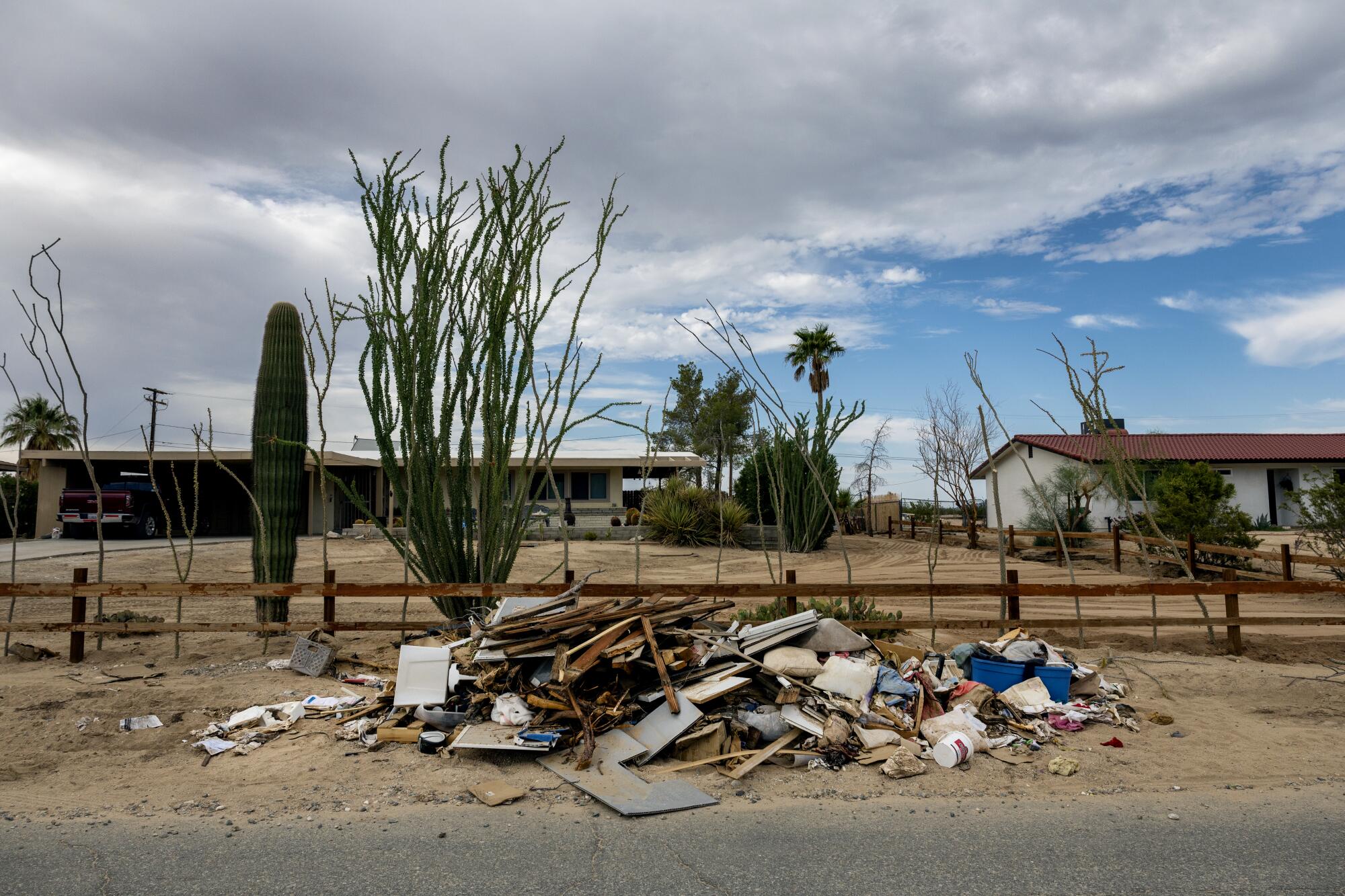
Leanna Stedman, 23, was out offroading with her husband when the hair on the top of her head stood up, which she took to be a sign of an impending storm. Within about 30 minutes of arriving home, her garage had taken on about 2½ feet of water, and water was flowing into her house.
She realized she needed to escape, but the garage door wouldn’t open. She called 911, but the emergency responders the operator connected her with hung up, she said. “They said, ‘We have so many other people we’re helping, you guys are gonna have to just figure it out,’” Stedman said. The 911 operator apologized and said the response was not typical, she added.
Stedman’s husband was eventually able to pry open the door, and she swam to his truck holding her squirming dogs. They drove through the floodwaters to a friend’s house across town.
“There were cars at the red light just floating, bumping into each other,” she said. She estimates she lost 70% to 80% of her possessions and isn’t sure when, or if, she’ll be able to return to the home she rented. Her renter’s insurance doesn’t cover water damage due to natural disasters, she said.
Like residents, city officials were also caught off guard, said Twentynine Palms Mayor Steven Bilderain.
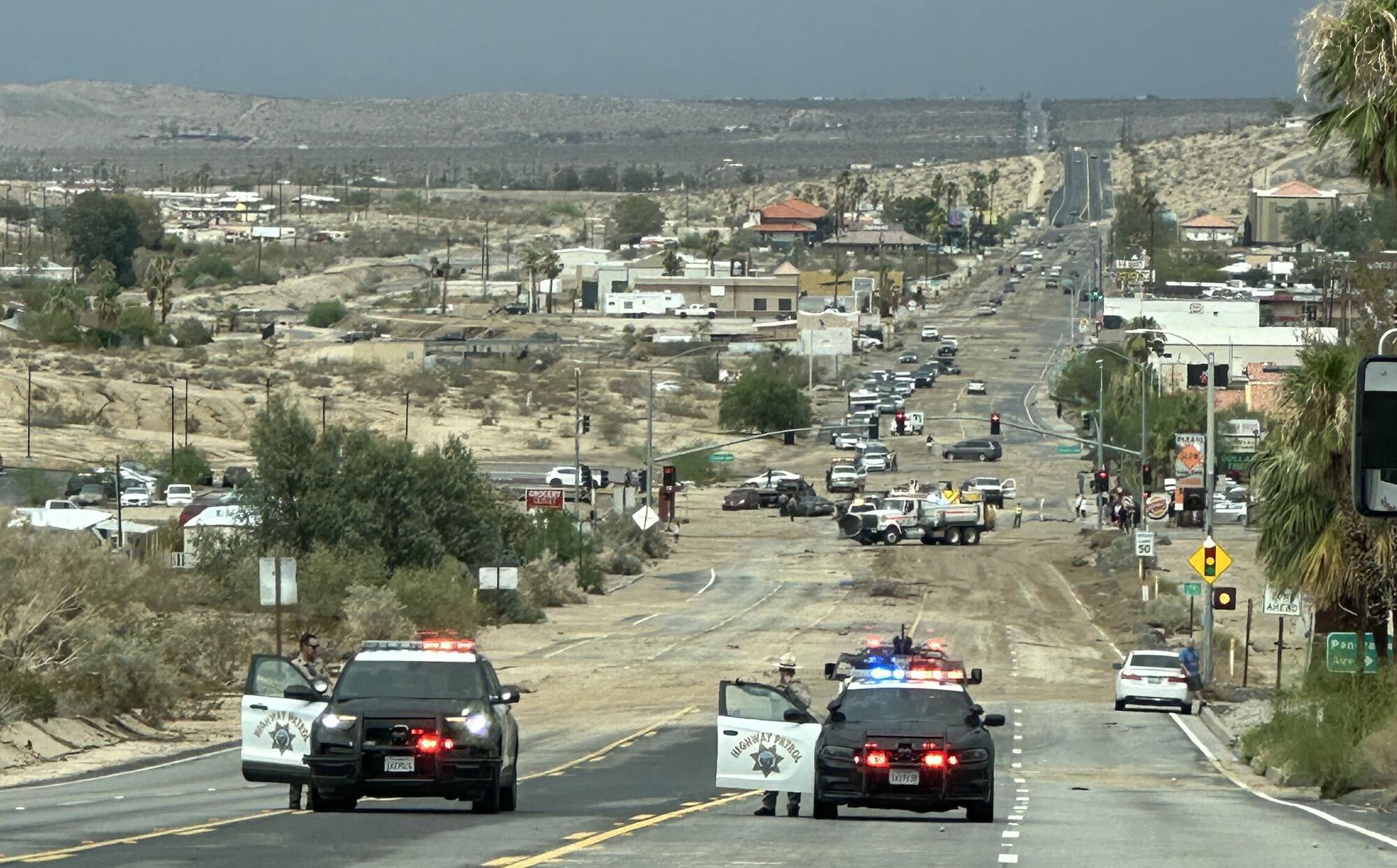
“Normally, when we know a storm is coming, we see it ahead of time, we prepare our vehicles, prepare the roads, have people on standby for potential flooding,” he said.
“This storm was different,” he added. “It hit everywhere that we were not prepared for based on the past.”
Still, Twentynine Palms’ small team of municipal employees mobilized quickly, he said, closing the floodgates that block streets prone to flooding. The city’s IT director, who doubles as its emergency services director, pivoted from addressing cybersecurity threats to dealing with flood mitigation, working 24 hours straight.
In the space of just a couple of hours that afternoon, the San Bernardino County Fire Department conducted three swift-water rescues and helped or rescued 17 people from their vehicles, said City Manager Stone James, who, like many employees, was out in the field helping to close floodgates. Ten people needed medical attention.
“There was an awful lot of activity behind the scenes that people didn’t see, that the city was incredibly proactive in,” he said.
What went wrong?
The storm left residents reeling. Some expressed frustration with the city for what they described as a lack of communication to affected residents in the immediate aftermath. Others wondered whether authorities could have done more to monitor the development of private properties that they believe may have intensified the flow of water into certain areas. In the days that followed, frustrations boiled over on social media and at a City Council meeting in which residents took to the podium to criticize officials’ response.
Erick Turner, 39, whose home was saturated with mud and water, lives near Twentynine Palms School. This was the first decent rain since a new football stadium was built there last year.
“Where does all that stadium water go? To my house,” said Turner, who manages an ampm and Cold Stone Creamery. “No flood drainage was done, no curbs and gutters.”
A seven-story boulder on federal land has become a tinderbox of tensions over who gets to enjoy this patch of Mojave Desert, which has rapidly gentrified since the COVID-19 pandemic.
He lost the flooring in his home. He can’t afford to replace the drywall and cabinets and is hoping they don’t becomeinfested with mold. He had to have a tractor pull out his truck, which sank into the mud.
“I’ve never dealt with something like this,” he said. “How do you react when you have something so big that you worked so hard for and you’re trying to save it?”
Dan Coleman, 53, owns a 12-bedroom apartment complex that was flooded. Tenants living in three of his four units — two of whom were pregnant — were displaced.
Many of his tenants are in the military, drawn to the city by its Marine Corps Air Ground Combat Center. “So when things like this happen, they don’t live in a city where their families live,” he said. “They don’t have any support.”
“There needs to be better communication from the city to the residents,” he added. “Is this a natural disaster? Is there going to be funding available?”
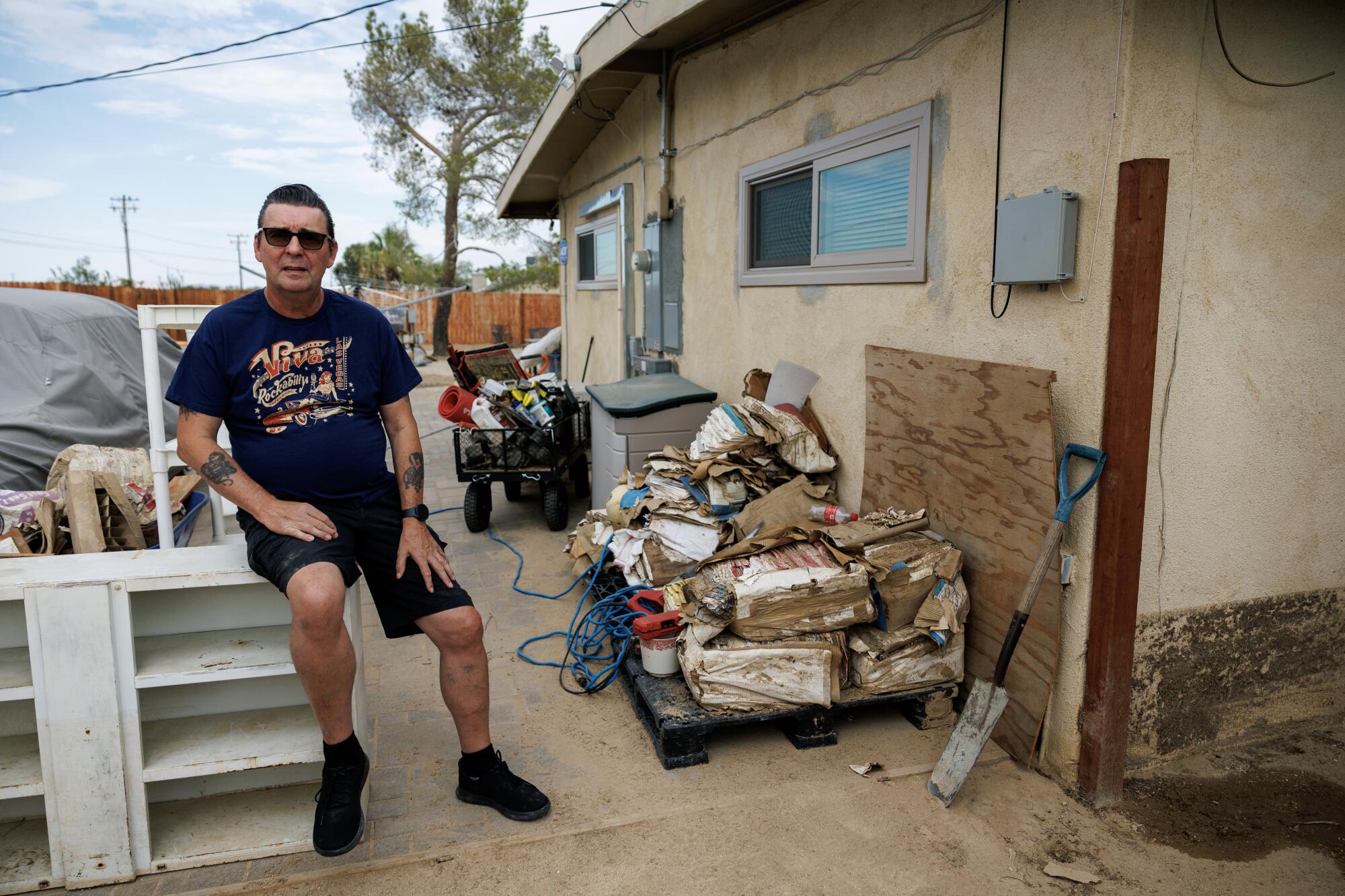
Tom Ingram, 63, last year moved from Los Alamitos to Twentynine Palms, where, he jokes, “I can live in a $2-million house that only cost $300,000 to buy.”
During the storm, a giant rush of water broke his fence, then began pouring through his air conditioning vents. Two outdoor sheds were propelled across the yard and broke apart, sending clothes and business paperwork flowing into the street.
Ingram’s home sits atop a hill, so he didn’t expect it to flood. After the deluge, he checked his security cameras and saw that the water was channeled his way by a wall built around a nearby housing tract, as well as an adjacent vacant lot that acted as a funnel. Public works crews removed 100 dump trucks worth of sand from the nearest intersection.
The radio show host, who also organizes a popular rockabilly festival in Las Vegas, questioned whether the potential flooding impacts were properly considered when the housing development was built, which records show took place in the mid-2000s.
The water took out his driveway and three fences and filled his air conditioner ducts and hot tub pumps and motors with wet sand. He must rip out portions of his walls and flooring and may need to replace the kitchen, although he bristles at the idea of overhauling his 1961 Midcentury Modern home, which he purchased precisely because so many of its original features were in good condition.
He estimates the repair costs and lost property at about $150,000. Still, he plans to stay and says he will build protections against the next flood.
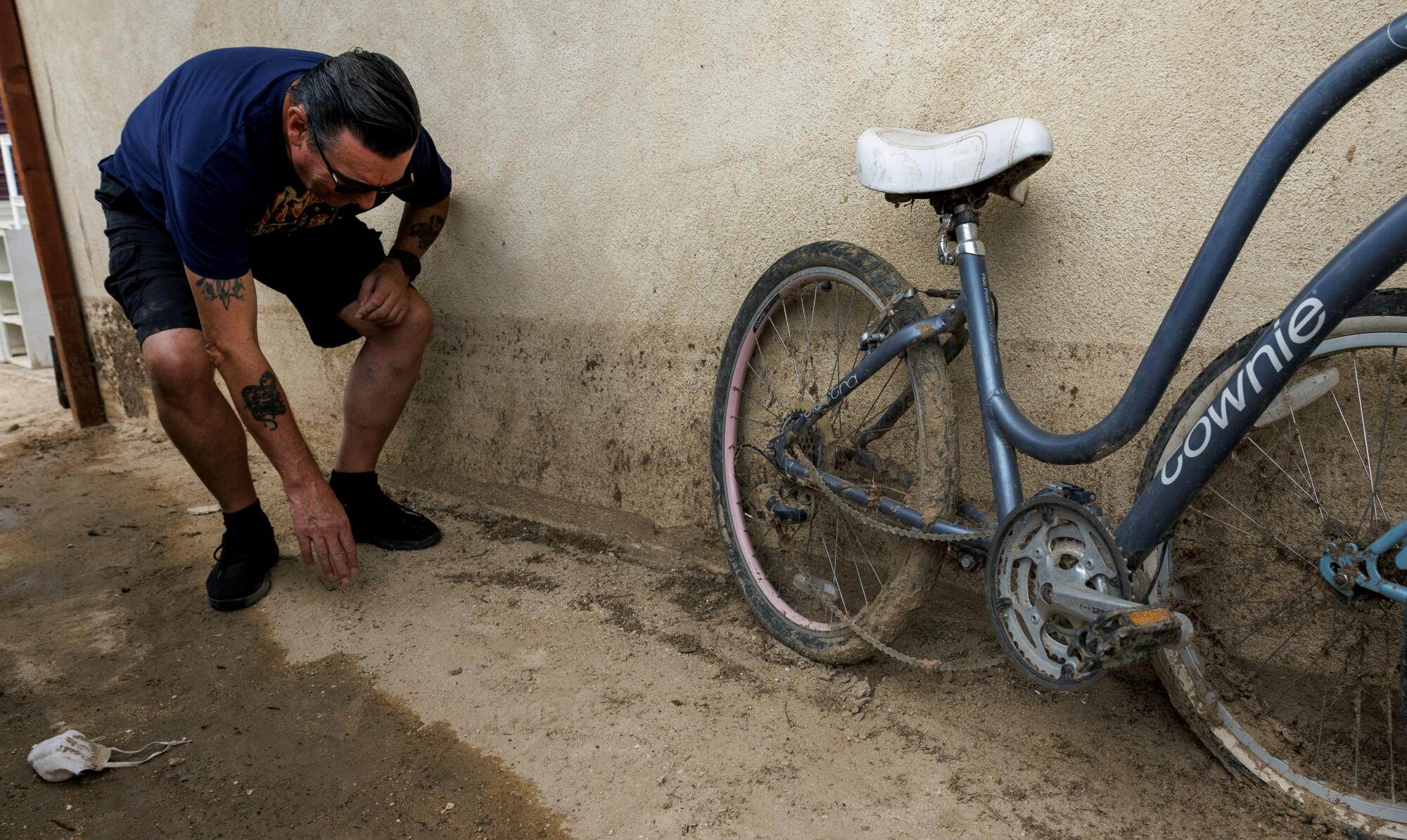
“I don’t think it will be a one-off,” he said. “I think it’s something we should start expecting because of all the changes in the weather patterns.”
Ingram has received cleanup assistance from two nonprofit groups, but nothing from the city or county, he said. Still, he says he’s one of the lucky ones, as he can recover without much help. But a lot of his neighbors can’t. Multiple nearby homes were rendered unlivable, and he worries they’ll sit empty.
Development projects are reviewed by professional engineers licensed by the state and must follow state hydrology standards, James, the city manager, said. Although San Bernardino County is responsible for flood control, the city will work to identify areas that were hardest-hit by the storm and determine whether there are steps they could recommend to the county to mitigate future flooding, he added.
And, although the city has done its best to respond to the devastation, he said, “with a staff of 40 in City Hall, we can’t do everything for everyone all at the same time.”
Amboy has been beset by a series of crises that stretch back more than half a century. But owner Kyle Okura hopes to turn it around. No less than his father’s legacy is at stake.
Supporting one another
In total, 150 homes were found to have sustained wind or flood damage, James said. Still, the estimated dollar amount fell short of the $10-million threshold needed to qualify for assistance from the Federal Emergency Management Agency, he said. The city has elected to not declare a local emergency, saying that doing so would not benefit residents.
Instead, city officials have focused efforts on connecting victims with nongovernmental organizations, in addition to clearing roads and fixing broken and exposed water mains, James said.
The Red Cross has assisted 25 families accounting for more than 70 people, and teams also distributed emergency supplies such as cleanup kits, water and snacks, said spokesperson Stephanie Fox.
In a low-slung building at a local community center, a handful of volunteers with veteran-led nonprofit Team Rubicon — known as “greyshirts” — billeted for four days, sleeping on cots and showering at the park across the street. James cooked them breakfast each morning.
The city connected the group with damaged homes that were in need of mucking out. They removed dirt, debris and damaged furniture, and tore out wet carpet and drywall at risk of mold growth, said incident commander James Coler, a retired Marine. In the end, they cleaned out eight homes, saving each homeowner an estimated $10,000 to $30,000, he said. They also held a public class demonstrating how to fill sandbags.
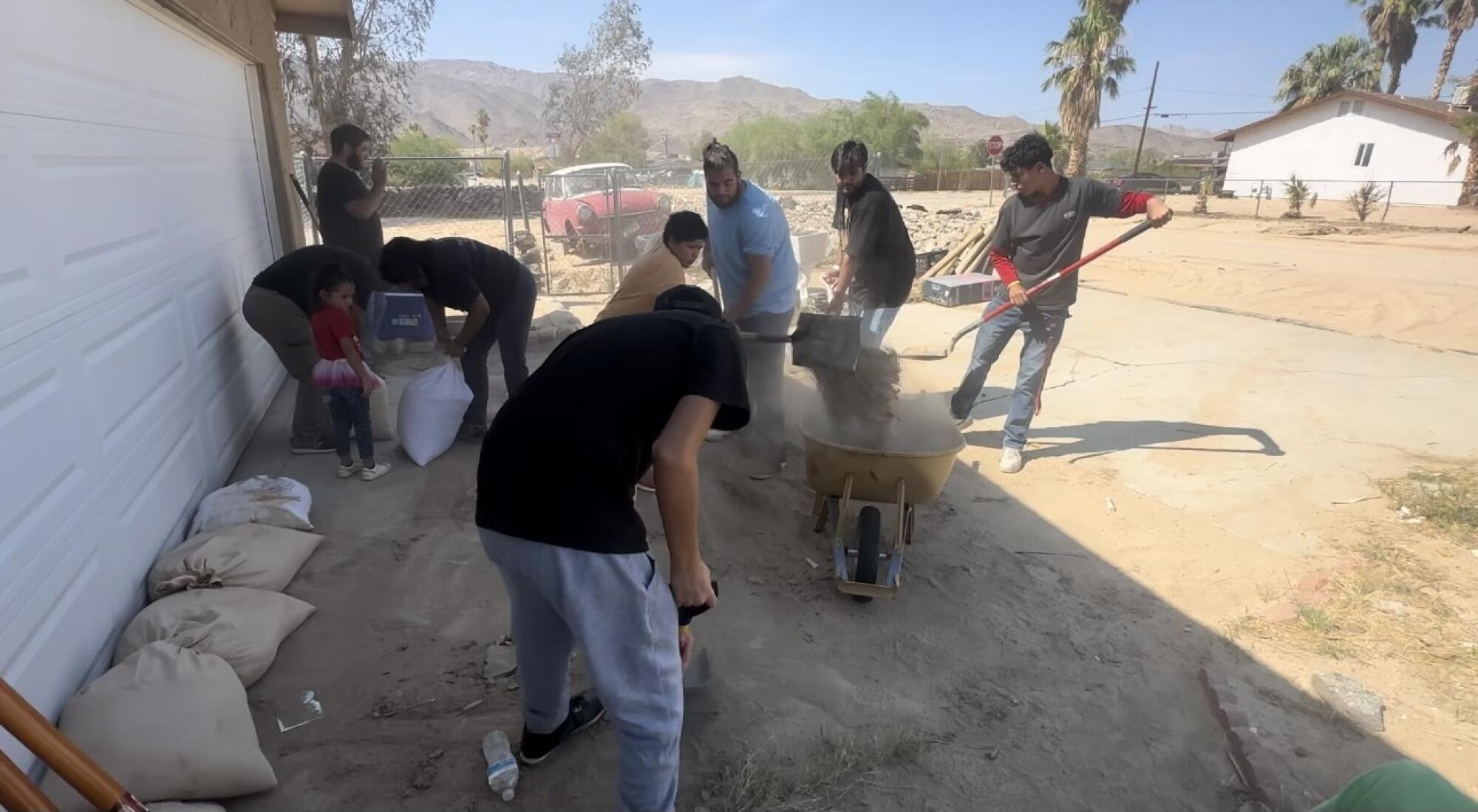
“When your neighbor’s yard washes into yours, unless you work together, nothing’s gonna get resolved,” Coler said. “And if you’re just angry about it, and then everybody blames the city, nothing’s gonna get done because you’re just consumed by anger. Why not just get your neighbors and then grab shovels?”
Inez Rodriguez-Alcaraz, 37, clearly felt the same way. She lives two towns over, in Yucca Valley, and has six sons, ages 4 to 18.
“I need to show them how to be good little men, and be productive in our community,” she said. “I figured what better way to show them how to care about people and help out than helping in Twentynine with the flooding?”
Together with a friend’s family, she and her sons helped clear mud from driveways and place sandbags. The group advertised their services on social media, and the effort grew.
The team is lending out shovels and other tools, handing out sandbags and food and coordinating volunteer and aid efforts.
Local Marines, City Councilman Octavious Scott and members of the rival Yucca Valley High School football team are pitching in.
“Usually we’ll talk smack about each other here and there,” Rodriguez-Alcarez said. “But with this going on, we’re not seeing each other as, ‘We’re just Yucca; we’re just Twentynine.’ We’re seeing each other as, ‘We’re the Morongo Basin, and we’re all just trying to help each other out.’”
Microburst rips through Wonder Valley. (Genea Gaudet)
On one recent afternoon, film director Genéa Gaudet, 50, was considering reaching out for help from the group. Her cabin was damaged not by the July 14 storm, but by a subsequent microburst 10 days later that ripped through Wonder Valley, an unincorporated community on the outskirts of Twentynine Palms. Winds blew off her roof and her neighbors’ and lifted a 5,000-pound cow trailer, sending it careening into the side of her house.
“This is a cool thing about the desert, and a nice thing about living in a rural area,” said Gaudet, who moved from Los Angeles in 2020. “It’s a nice aspect to have that type of community that you don’t kind of get in a big city.”
Snake wrangler Danielle Wall has become a celebrity in California’s high desert. But you’ll learn about more than snakes if you tag along.

